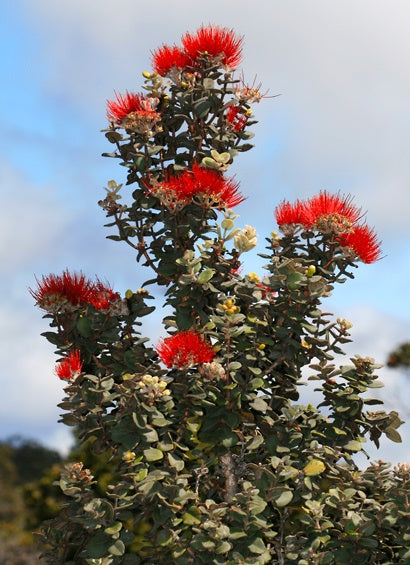
The Hawaiian people began their unique and deeply interconnected relationship with nature back in ancient times. It was then that Mother Earth was an integral player in their survival and even became a major player in their culture and day to day beliefs, especially trees.
The Story of The Ohia Lehua Tree
Since ancient times, the Ohia Lehua tree has been a much loved member of native forests with many culturally symbolic meanings and uses.

Growing in abundance on both wet, dry, high and low geographic zones of the island, each part of the Ohia was used by early Hawaiians. For example, its sturdy wood was used to create weapons while its leaves were crafted into medicinal tea. Even the native birds who fed from the Ohia Lehua’s rich nectar were prized possessions when it came to adornments for ceremonies like hula. No to mention, traditional Hawaiian moolelo (stories), mele (songs) and oli (chats) about the Gods almost never fail to make some mention of the Ohia tree or its Lehua flowers.
The Ohia's ashy bark and firecracker-esque blooms are tied to a well known Hawaiian story that tells the tale of the trees very creation. Hawaiian legend says that Pele, goddess of fire, once met a handsome warrior named Ohia whom she asked to marry her. Ohia, however, had already pledged his love to Lehua. Pele was furious when Ohia turned down her marriage proposal, so she turned Ohia into a gnarled and twisted tree. A heartbroken Lehua begged for the spell to be reversed but Pele remained full of spite and refused to undo the spell. After much begging on Lehua’s end, the other Gods took pity upon her and decided they would ensure that the lovers should remain together forever. Thus, they transformed Lehua into a blossom on the Ohia tree so that the two would be forever intertwined. The same legend also alludes to a relationship between the Lehua blossoms and rain as the tears of the two lovers. It is said that once a Lehua flower is picked, it will rain. To evoke these gods, hula dancers are often adorned with lehua blossoms while ohia branches are used to create traditional dancing sticks.
Fungal Disease and Invasive Species Pose an Imminent Threat
Sadly, the population of Ohia trees across Hawaii are in imminent danger thanks to a fungal disease called Rapid Ohia Death (ROD). Healthy trees fall ill and die within a few days or weeks. As a result, ROD has already taken the lives of hundreds of thousands of Ohia trees across the Big Island. Although the disease is only found on the Big Island, the entire population of Ohia across each of the islands is susceptible to ROD.
Flint Hughes, a research ecologist with the US Department of Agriculture Forest Service states that the Ohia “is

While stopping ROD is posing some serious challenges, Waiakea employees have been participating in volunteer efforts along with the Keau’ohana Forest Reserve Restoration Project to rid the Keau’ohana Forest of invasive species that pose a threat to the Ohia tree.
Jaya, founder of the Keau’ohana Forest Reserve Restoration Project, showed Waiakea employees many important things that are needed to know in order to help the Ohia trees. Jaya has been taking care of the forest for over 3 years and is still in love with what she does, but she needs continued support of not just Waiakea’s team, but the island’s ohana.
Community Involvement In 2017 -- the Big Island
Once a month, Waiakea employees volunteer in the community, focusing on the environmental and educational needs of Hilo and surrounding areas.
Waiakea participated in the 2017 Hilo Heart & Stroke Walk on April 1st, 2017. We ensured that each and every 'heartwalker' was properly hydrated during their walk to encourage the building of healthier lives, free of cardiovascular diseases and stroke. Waiakea was also a proud participant in the Rotary Club of South Hilo's event earlier last month. The Rotary club is a leadership organization comprised of local business, professional and civic leaders who meet regularly in order to drive positive change within the greater community.
